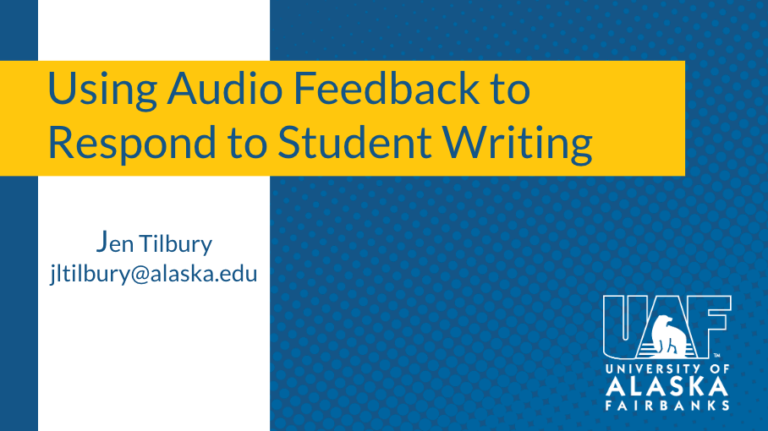Gathering student feedback
Sometimes while preparing a course, we struggle to make design decisions because we haven’t met our students yet. At this point in the semester, you’ve met and worked with your students, and they’ve worked with your course design. How did it go? How do you know? What can you learn from them to help future students that you haven’t met yet?
Before you launch into a feedback process, establish what you’d like to know from students. Whether they liked or disliked a particular assignment may not matter to you, but whether they changed their ideas or practices based on the course might. How, if at all, did students connect the work of your class to their other classes, to their careers, communities?
Survey
UAF offers student end-of-course evaluations via the “Blue survey. This semester, student evaluations will be accepted until December 8th. While it’s too late to customize questions for your classes (more on that here), the standard questions are helpful — but only if students respond! Here are some ways you can encourage student responses:
- Set aside time in class. Note that because the Blue system is online, you’ll need to remind students to bring internet-connected devices for this purpose.
- Offer extra credit to the whole class for a 100% response rate. Note that you cannot offer credit only to those who have responded to the survey– responses are anonymous and asking students to self-report whether they’ve responded defies full anonymity.
- Motivate students to respond by sharing the purpose of the evaluations, and how you plan to use the feedback they give.
Note that the Blue evaluations are for soliciting end-of-semester feedback, but you can create your own survey (try Google Forms) anytime during the semester. When you ask students for feedback mid-semester, you have the chance to make adjustments and show them the value of their feedback.
Group Discussions
While a survey is simple and anonymous, talking with your students about the course and the feedback you’re after affords the opportunity for follow-up questions and dialogue. If you don’t see a full-class discussion working for you, try having these conversations in one-on-one conferences with students, via a focus group of students representative of the class, or allow students to lead the discussions in small groups and then report the feedback back to you. Importantly, talking with your students about the class allows them to see that you are listening and taking their feedback seriously.
Revise Together
Spend a class period (or in the case of an online course, create an assignment) on revising the course schedule and/or syllabus together. To structure this revision, you might prompt students to work in groups and
- Eliminate one module from the course schedule, and recommend a few topics that might replace it;
- Change one policy in the syllabus;
- Rewrite the syllabus as an FAQ;
- Rewrite the course description.
While you may not implement any of the suggested changes, you might look for patterns in the suggestions. Did everyone ditch Module 3? Why might that be?
Finally, when you get all the feedback back and find (almost inevitably) that in at least a few categories, students had markedly different opinions on what worked and what could’ve gone better, do not throw up your hands and abandon the project! Instead, focus on what you can learn from the results; what’s new or surprising to you in the feedback? Is this type of feedback helpful to you or should you ask different questions / use a different method next time?
As you move into preparing your courses for next semester, consider integrating opportunities for student feedback throughout the semester. Feedback is most helpful when it can be used immediately and students can see its impact; building trust by showing you are listening can be as valuable to students as the feedback is to you.
Resources:
Brennan, J., & Williams, R. (2006). Collecting and using student feedback: a guide to good practice. Learning and Teaching Support Network.

Kendell Newman Sadiik
Associate Director of Transformative Teaching
Instructional Designer
LION Liaison



